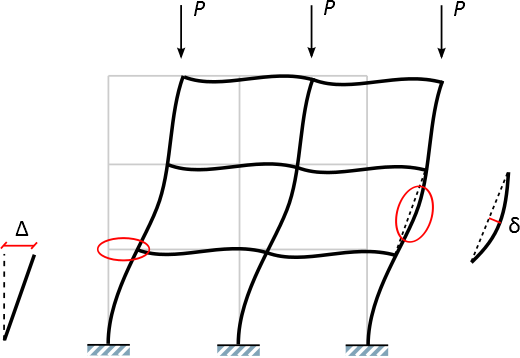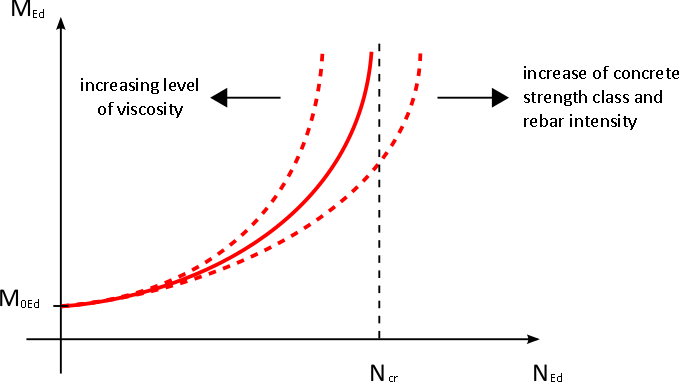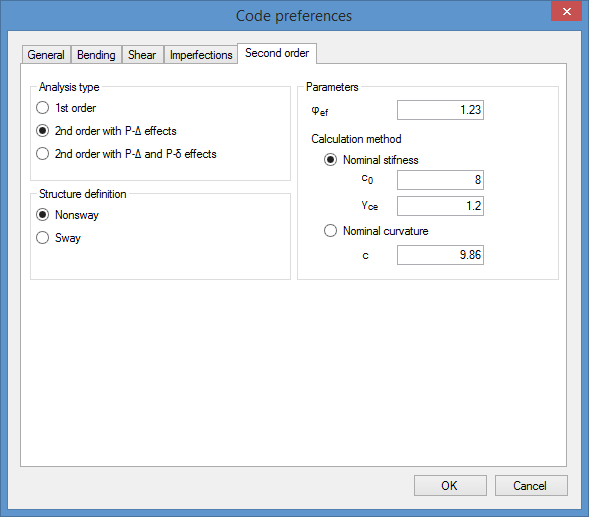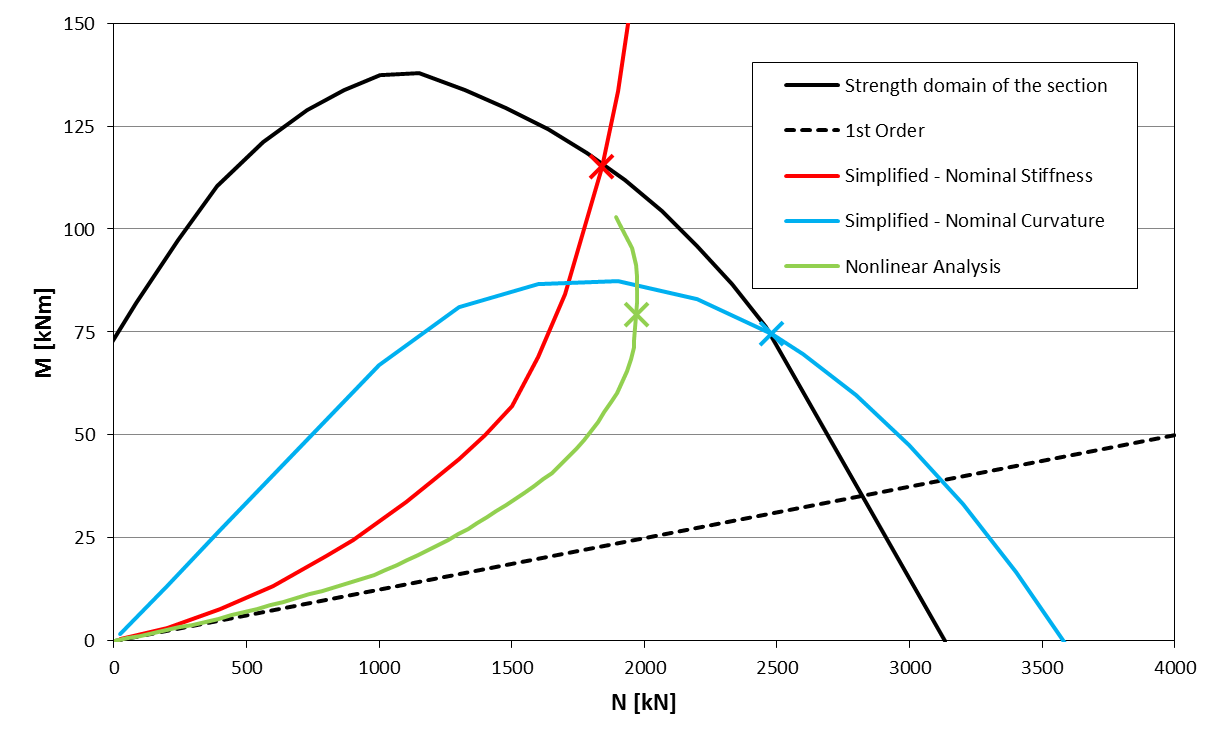COMPARISON OF THE ANALYSIS METHODS FOR THE EVALUATION OF LOCAL SECOND ORDER EFFECTS IN CONCRETE STRUCTURES – “NOMINAL STIFFNESS” METHOD AND “NOMINAL CURVATURE” METHOD
Topic: Second order effects in concrete structures
Author: Andrea Bidoli
Company: CSi Italia srl
Contact: support@csi-italia.eu
Download: This Report is also available in PDF [click here]
Introduction
Second order effects in concrete structures are largely influenced by several nonlinear factors such as cracking of sections and viscosity of the material. A detailed analysis of the phenomenon would imply the use of complex models that are not suitable for the analysis of entire structures. For this reason, all the modern design codes propose the use of simplified methods for the evaluation of second-order effects in structural elements. Such approaches have the significant advantage of being applied to the analysis results, amplifying the member’s forces by a proper factor.
The simplified methods provided by the main international design codes can be divided into two separate categories: methods based on the “nominal stiffness” of the elements (EC2, ACI 318) and methods based on the “nominal curvature” (EC2). The aim of this paper is to evaluate the accuracy of these procedures in the determination of local second-order effects in concrete columns and to provide appropriate guidelines for their application within the VIS software. At this purpose, the results obtained with the simplified methods have been compared with those corresponding to a general nonlinear analysis, as defined at § 5.8.6 of UNI EN 1992-1-1, which includes the effects of geometric and material nonlinearity.
Second order effects in concrete buildings
Second order or “P-Delta” effects refer to the nonlinear effect of a large tensile or compressive force upon transverse bending and shear behaviour of elements. A compressive stress tends to make a member more flexible, while a tensile stress tends to stiffen it against transverse deformation (see Figure 1).
Second order effects in buildings can be divided into two different categories, graphically represented in Figure 2: global (P-Δ) effects due to story drifts, and local (P-δ) effects due to members deformation between their ends. Global effects are mainly generated by lateral loads (wind, earthquake…) and their magnitude depends on the compression forces acting on the vertical members and on the expected degree of cracking expected in the lateral resisting elements. Generally, P-Δ effects effects generated from wind or earthquake loads are not influenced by creep, given the short-term nature of those loads, but the global effects arising from geometrical imperfections or other permanent lateral loads are. Local effects, on the contrary, are primarily caused by the gravity loads and thus are always strongly affected by the viscous behavior of the concrete.
The most accurate approach to evaluate the P-Δ effects is to run an elastic second order analysis, which directly accounts for the coupling between axial and bending behaviour of elements. Material nonlinearity is not explicitly modeled, but its effect can be reasonably approximated by assigning appropriate stiffness modifiers to the different elements basing on the expected degree of cracking and on the pertinent level of creep.
A similar “direct” approach can not be easily extended to the analysis of local effects: the necessity to account for creep, distributed in-span imperfections and material nonlinearity would make the modeling very complex and less versatile. For all these reasons the most common techniques to account for P-δ effects are represented by simplified methods that consist in amplifying the analysis forces as a function of the member’s slenderness, compression level, degree of cracking and creep.

Figure 1: second order or “P-Delta” effect

Figure 2: global and local second order effects in buildings
Simplified methods for the evaluation of second order effects
All the simplified methods are based upon an analogy with a “model” column having the following properties:
– constant cross section along the length;
– pinned restraints at both ends;
– constant axial force and bending moment;
– no transversal loads applied over the length.
Each structural member must first be referred to the corresponding model column by determining its effective length and equivalent moment.
The equivalent moment, \(M_{0}\), is calculated with reference to the extreme moments, \(M_{1}\) and \(M_{2}\). Both the European code (EC2) and the American code (ACI 318-14) use the same expression for \(M_{0}\), precisely:
\(M_{0}=0.6\cdot M_{2}+0.4\cdot M_{1} \geq 0.4\cdot M_{2}\)
where \(|M_{2}| \geq |M_{1}|\). The signs of \(M_{1}\) and \(M_{2}\) coincide if the column is bent in single curvature, otherwise they are opposite.
The effective length is defined by the distance between two consecutive inflection points in the critical deformed shape of the element. Both the European (EC2 § 5.8.3.2) and the American (ACI 318-14 R6.2.5) codes provide approximate methods to calculate effective lengths based on the relative rotational stiffness at the ends of the member.
Once the equivalent column model has been determined, local second order effects can be estimated as a function of the maximum expected inflection, calculated according to the “nominal stiffness” method (EC2 and ACI 318) or to the “nominal curvature” method (EC2).

Figure 3: definition of the equivalent “model” column
a) determination of the equivalent moment – b) calculation of effective length
The American code explicitly states that the global P-Δ effects should be included in the calculation of the equivalent moment, therefore the effective lengths to be used in the evaluation of local effects must always be determined with reference to the non-sway condition. The Eurocode vice versa allows to use the values of \(M_{1}\) and \(M_{2}\) derived from a simple first order analysis and thus, in such cases, effective lengths must be determined assuming a sway condition. The latter approach however is not recommended, since the simplified methods used for the determination of local effects are not conceived for the analysis of global effects also. For this reason, when P-Δ effects are expected to be relevant, it is always preferable to evaluate them using a dedicated approach and include them in the calculation of \(M_{0}\).
Nominal Stiffness method
The equilibrium of the model column with reference to its deformed configuration is governed by the following second order differential equation:
\( v” EJ+Nv=-Ne_{0} \)
where \( v \) is the lateral deflection of the column and \( e_{0}=M_{0}/N \). By solving this equation it is possible to determine the maximum moment acting in the middle section of the member as a function of its Euler critical load:
\( M_{max} = \cfrac{M_0}{\left ( 1 – \cfrac{N_{Ed}}{N_{cr}} \right )} \)
In the expression above the only unknown is represented by the critical load \( N_{cr} \):
\( N_{cr} = \cfrac{\pi^2 \left ( EJ \right )_{eff}}{L^2_0} \)
The value of this term is proportional to the effective or “nominal” stiffness \( \left ( EI \right )_{eff} \) of the column, which is influenced by its slenderness, the degree of cracking and the expected viscosity.
The Eurocode 2 gives the following expression for the nominal stiffness (EC2 § 5.8.7.2):
\( EI=K_{c} E_{cd} I_{c} + E_{s} I_{s} \)
where the \( K_{c} \) term reduce the stiffness of the concrete to account for cracking, slenderness and viscosity:
\( K_{c} = \cfrac{k_{1} k_{2}}{1+\varphi_{ef}} \)
\( k_1 = \sqrt { \left ( f_{ck}/20 \right )} \) with \( f_{ck} \) in MPa
\( k_2 = n \cdot \lambda / 170 \leq 0.2 \rightarrow \) slenderness factor
\( n = N_{Ed} / \left ( A_c f_{cd} \right ) \rightarrow \) relative axial force
\( \lambda \rightarrow \) slenderness of the column in the current direction
\( \varphi_{ef} = \varphi \left ( \infty, t_0 \right ) \cdot M_{0Eqp} / M_{0Ed} \rightarrow \) effective creep ratio
\( M_{0Eqp} \rightarrow \) first order bending moment corresponding to the quasi-permanent design load combination
\( M_{0Ed} \rightarrow \) first order bending moment corresponding to the ultimate design load combination
\( \varphi \left ( \infty, t_0 \right ) \rightarrow \) final creep coefficient as defined in Figure 4
The final design moment is then defined by:
\( M_{Ed} = M_{0Ed} \left [ 1+\dfrac {\beta}{\dfrac{N_B}{N_{Ed}} -1} \right] \)
in which \( M_{0Ed} \) represents the equivalent moment, \( N_B \) is the critical load calculated with reference to the nominal stiffness and \( \beta \) is a correction factor which depends upon the distribution of moments along the column and can be generally assumed equal to \( \pi^2 / 8 \).

Figure 4: estimation of the final creep coefficient (EC2 fig. 3.1)
The American code proposes three different formulations for the nominal stiffness (ACI 318-14 § 6.6.4.4.4):
\( \begin{array}{l}\left( EI \right )_{eff} = \dfrac{0.4 \cdot E_c I_g }{1 + \beta_{dns}} \\ \\ \left( EI \right )_{eff} = \dfrac{0.2 \cdot E_c I_g + E_s I_{se}}{1 + \beta_{dns}} \\ \\ \left( EI \right )_{eff} = \dfrac{E_c I}{1 + \beta_{dns}} \end{array}\)
in which:
\( I_g \) moment of inertia of gross concrete section about centroidal axis neglecting reinforcement
\( I_{se} \) moment of inertia of reinforcement about centroidal axis of member cross section
\( I \) moment of inertia of section calculated according to table 6.6.3.1.1.(b) of the code
\( \beta_{dns} \) ratio of maximum factored sustained axial load to maximum factored axial load corresponding to the considered load combination
The maximum bending moment is then calculated as:
\( M_c= \delta \cdot M_2 \)
with
\( \delta = \dfrac{C_m}{1 – \dfrac{P_u}{0.75 \cdot P_c}} \geq 1 \)
In the previous expression \( P_c \) identifies the critical axial force, calculated with reference to the effective stiffness, and \( C_m = 0.6 – 0.4 \cdot M_1 / M_2 \) represents the equivalent moment coefficient.
The formulations proposed by both the codes are very similar but the Eurocode adopts a more refined approach to account for viscous effects by considering the influence of environmental conditions, notional size of the elements, strength class of the concrete and age of the concrete at the time of loading; whereas the American code uses a simplified approach based on the ratio between the sustained load and the total load.
The curve that represents the total moment in the column as a function of the axial force tends asymptotically to infinite when \( N \rightarrow N_{cr} \) (see Figure 5).

Figure 5: maximum total moment acting in the column model according to the nominal stiffness method
Nominal Curvature method
The nominal curvature method is based on a completely different approach: with reference to Figure 6, the red curve represents the M-N interaction surface of the column’s section without considering second order effects; the model column, however, could not withstands the theoretical value of resisting moment at its ends, because the induced deflection generates an additional bending moment in the middle section that causes the premature collapse of the member. Therefore given the design value of the axial force, \( N_{Ed} \), and the corresponding total deflection at collapse, \( e_2 \), the maximum value of bending moment that the column can develop will be:
\( M’_{Rd} = M_{Rd} – N_{Ed} \cdot e_2 \)
The strength check can then be expressed in the following form:
\( M_{Sd} + N_{Ed} \cdot e_2 \leq M_{Rd} \)
where the term \( N_{Ed} \cdot e_2 \) defines the second order contribution at collapse.

Figure 6: reduction of column’s resisting moment due to second order effects
In the previous equation the only unknown is represented by the deflection \( e_2 \). For the calculation of this term, a sinusoidal distribution of displacements along the columns is assumed:
\( e(x) = e_2 \cdot \sin \left ( \dfrac{\pi}{L} x \right ) \)
By indicating with \( 1/r \) the curvature of the middle section at collapse, the corresponding deflection can be expressed by:
\( \dfrac{1}{r} = e” \left ( \dfrac{L}{2} \right ) = e_2 \cdot \dfrac{\pi^2}{L^2} \rightarrow e_2 = \dfrac{1}{r} \cdot \dfrac{L^2}{\pi^2} \)
EC2 (EC2 § 5.8.8.3) suggests the following formulation for the curvature:
\( \dfrac{1}{r} = K_r \cdot K_{\varphi} \cdot \dfrac{1}{r_0} \)
where
\( 1 / r_0 = ε_{yd} / ( 0.45 \cdot d ) \rightarrow \) base value of the curvature
\( K_r = (n_u-n) / (n_u – n_{bal} ) \leq 1 \rightarrow \) correction factor depending on axial load
\( n_u = 1 + \omega \rightarrow \) relative compression strength of the section
\( n = N_{Ed} / (A_c f_{cd} ) \rightarrow \) relative axial force
\( n_{bal} \rightarrow \) value of \( n \) at maximum moment resistance
\( K_{\varphi} = 1 + \beta \varphi_{ef} \geq 1 \rightarrow \) correction factor that accounts for creep
\( \varphi_{ef} \rightarrow \) effective creep ratio (see previous paragraph)
\( \beta = 0.35 + f_{ck} / 200 -\lambda / 150 \rightarrow \) slenderness factor
\( \lambda \rightarrow \) slenderness ratio of the column
For \( n < n_{bal} \) the curvature is constant and its magnitude increases with the concrete class and the level of viscosity. When \( n > n_{bal} \) the curvature starts to decrease and becomes zero for \( n = n_u \).

Figure 7: curvature distribution in the critical section of the column
Comparing the second order moment calculated with the “nominal curvature” approach with the one corresponding to the “nominal stiffness” method the difference is noticeable (see Figure 8): the latter tends to infinite when \( N_{Ed} \rightarrow N_{cr} \) while the first decreases as \( N_{Ed} > N_{bal} \). The main problem with the curvature approach is that it assumes that configuration of the column at collapse is always stable whereas, if the axial force exceeds the critical value, this is not true and the equilibrium could not be enforced.

Figure 8: second order moment in the model column.
a) “nominal stiffness” method – b) “nominal curvature” method
General method based on nonlinear analysis
As an alternative to the simplified methods, the Eurocode 2 allows to use a more general approach, based on a nonlinear analysis, for the evaluation of local second order effects. Such analysis must explicitly model material nonlinearity and account for creep and imperfections and thus requires a high computational effort. For this reason its application to the analysis of entire buildings is fairly limited but, on the contrary, this method represents a very powerful tool for the evaluation of local effects in isolated members, whose internal forces have been calculated by an elastic second order analysis of the entire structure. In this way it is possible to obtain very accurate results by considering the effective distribution of moments along the element.

Figure 9: evaluation of local second order effects in isolated members through a general nonlinear analysis
The Eurocode 2 provides detailed information about the constitutive laws to use for the different materials (EC2 § 5.8.6(3)). For concrete the following a “no-tension” model is adopted (EC2 Eq. 3.14):
\( \dfrac{\sigma_c}{f_{cd}} = \dfrac{(k \eta – \eta^2)}{1 + \left ( k-2 \right ) \eta} \)
where
\( \eta = \varepsilon_c / \epsilon_{c1} \rightarrow\) strain ratio
\( \varepsilon_{c1} (‰) = 0.7 \cdot \left ( f_{cd} \right )^{0.31} < 2.8 \rightarrow\) strain at maximum strength
\( k = 1.05 \cdot E_{cm} / \gamma_{cE} \cdot |\varepsilon_{c1} | / f_{cd} \rightarrow\) relative stiffness
In the absence of more refined model, creep may be taken into account by multiplying all the strain values by a factor \( (1+\varphi_{ef}) \).

Figure 10: nonlinear stress-strain diagram for concrete.
a) Without creep – b) With creep
For reinforcing steel, a symmetric elastic-perfectly plastic distribution is assumed (EC2 § 3.2.7).

Figure 11: elastic-perfectly plastic stress-strain distribution for steel
Comparison of the analysis methods for the evaluation of local second order effects
In order to determine the accuracy of the available methods for the evaluation of local second order effects in concrete members, the results in term of maximum axial capacity obtained for the same model column have been compared. The approaches that have been taken into consideration are:
1. nominal stiffness method as defined in EC2 § 5.8.7;
2. nominal curvature method as defined in EC2 § 5.8.8;
3. general method, based on a nonlinear analysis, as defined in EC2 § 5.8.6 and run with the SAP2000 commercial software.
The case study was represented by an isolated column with a section of 30 by 30 cm and an effective length of 5 m subjected to an eccentric axial load. The eccentricity of the load has been assumed constant and equal to the value corresponding to the geometric imperfections for isolated members as defined in EC2 § 5.2(7):
\( e_0 = l_0/400 \)
The maximum axial capacity according to the simplified methods has been evaluated by calculating the amplified bending moment corresponding to increasing values of axial force until the curve intersected the M-N strength domain of the section (see Figure 12). The capacity corresponding to the nonlinear analysis has instead been estimated based on the curves obtained from a displacement control analysis at fixed eccentricity ( see Figure 13).
Figure 12: maximum axial capacity of the column calculated through the simplified methods.
a) Nominal stiffness method – b) Nominal curvature method

Figure 13: maximum axial capacity of the column calculated through a nonlinear FEM analysis
The influence of concrete strength and rebar intensity have been evaluated by considering two different concrete classes and reinforcing arrangements. Creep effects have been included assuming a time of initial load, \( t_0 \), equal to 28 days and a ratio between quasi-permanent loads and ultimate loads equal to 0.62.
All the tested configurations are reported in the following table.

In order to evaluate the accuracy of the simplified methods, the results corresponding to the nonlinear analysis have been assumed as reference values. The nominal stiffness approach resulted in good accordance with the general method and always produced conservative results with an average underestimation of strength of about 7%. On the contrary, the axial capacities calculated with the nominal curvature method were always higher than the reference values, with an average overestimation of more than 25%.

The same comparison has been repeated for another model column with the same properties but a lower effective length, reduced to 3 m. In this case both the simplified approaches provided slightly unconservative results with an average overestimation of the final axial capacity of about 8% for the nominal stiffness method and 11% for the nominal curvature method.


By looking at the detailed graphical results (reported in the figures below) the nominal stiffness method appears to be more accurate in predicting the behavior of each configuration of both the long and the short column and produced conservative results for almost any range of admissible axial forces. The nominal curvature approach on the contrary, resulted over-conservative for low values of axial force while it became unconservative for increasing value of N. Both the simplified methods slightly underestimated the response of the short column for high values of axial force.
 Figure 14: section 30×30 | \( f_{ck}=32 \) | \( 4 \phi 16 \) | \( L_0 = 5m \) | \( \varphi_{ef} = 1.23 \)
Figure 14: section 30×30 | \( f_{ck}=32 \) | \( 4 \phi 16 \) | \( L_0 = 5m \) | \( \varphi_{ef} = 1.23 \)

Figure 15: section 30×30 | \( f_{ck}=32 \) | \( 8 \phi 16 \) | \( L_0 = 5m \) | \( \varphi_{ef} = 1.23 \)

Figure 16: section 30×30 | \( f_{ck}=50 \) | \( 4 \phi 16 \) | \( L_0 = 5m \) | \( \varphi_{ef} = 0.80 \)
Figure 17: section 30×30 | \( f_{ck}=50 \) | \( 8 \phi 16 \) | \( L_0 = 5m \) | \( \varphi_{ef} = 0.80 \)

Figure 18: section 30×30 | \( f_{ck}=32 \) | \( 4 \phi 16 \) | \( L_0 = 3m \) | \( \varphi_{ef} = 1.23 \)

Figure 19: section 30×30 | \( f_{ck}=32 \) | \( 8 \phi 16 \) | \( L_0 = 3m \) | \( \varphi_{ef} = 1.23 \)

Figure 20: section 30×30 | \( f_{ck}=50 \) | \( 4 \phi 16 \) | \( L_0 = 3m \) | \( \varphi_{ef} = 0.80 \)

Figure 21: section 30×30 | \( f_{ck}=50 \) | \( 8 \phi 16 \) | \( L_0 = 3m \) | \( \varphi_{ef} = 0.80 \)
Implementation of the simplified methods in the software VIS
Local second order effects in concrete members are directly influenced by several different variables such as cracking of sections, creep, slenderness ratios and geometric imperfections. A correct design approach must take into consideration all these aspects in order to prevent possible local failures of slender members. The modern design codes provide simplified methods to amplify the design forces on slender columns based on the corresponding nominal stiffness (EC2 and ACI 318) or the expected nominal curvature at collapse (EC2). The first approach is recommended, especially in the case of slender columns.
The VIS program, by CSi Italia srl, provides the users with comprehensive options for the evaluation of local second order effects in concrete columns (see Figure 22): the default method is the “nominal stiffness” but the “nominal curvature” approach can also be selected.
Effective lengths of columns can be automatically calculated by the program according to EC2 § 5.8.3.2 basing on the type of analysis (1st Order or 2nd Order) and structure’s definition (sway or non sway). If an ordinary linear analysis has been performed and the structure has been defined as sway, the program will consider also the contribution of global effects by using an effective length greater than the length of the element (EC2 Eq. 5.16). This approach is however not recommended and, when P-Δ effects are expected to be significant, it is always preferable to run a second order analysis to model global effects and use the simplified methods to account for local effects only.
The influence of geometric imperfections can also be added: equivalent moments will be calculated considering all the possible permutations of accidental eccentricity along each principal direction.
For detailed information about the design procedure used in the VIS program to account for second order effects, please refer to the § 1.2 and § 2.1.3 of the “VIS Design Manual” that is available in the “Download” section of our website.

Figure 22: second order settings

Figure 23: geometric imperfections definition
References
1. American Concrete Institute – Building Code Requirements for Structural Concrete and Commentary (ACI 318M-14). Farmington Hills, 2015.
2. Computers & Structures Inc. – CSi Analysis Reference Manual. Walnut Creek, 2016.
3. COMITÉ EUROPÉEN DE NORMALISATION – EN 1992-1-1:2004. Brussels, 2004.





